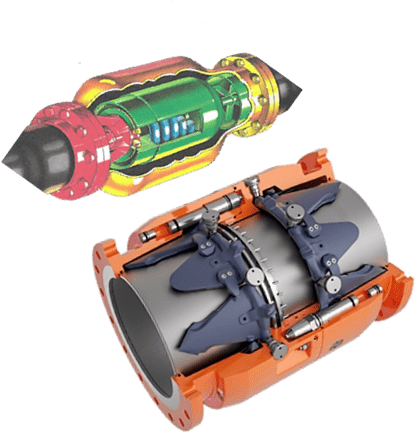MARINE BREAKAWAY COUPLINGS
MARINE BREAKAWAY COUPLINGS
During the late 1960s and early 70s the use of Hose Breakaway Couplings (MBC) at offshore terminals was considered by many operators as a “nice to have” item in their SPM or MBM package, in fact some even thought of an MBC as “another thing to go wrong”!Devoting their R&D time and funding to other more diverse solutions for oil & gas, an MBC was not seen at that time as a target market for MIB. There were of course exceptions to the standard applications where some project demanded more specialised solutions to the conventional ‘weak bolt’ MBC concept.
One such example of these almost unique requests was generated by Shell Exploration & Production in Aberdeen, Scotland. Wishing to develop their Fulmar field in the UK North Sea, and with a lack of existing infrastructure at the time, Shell selected to use a floating FSU for the crude oil coming from the Fulmar Production Platform. The Fulmar floating storage unit (FSU), was a 210,000 dwt converted tanker with stern tandem offloading to shuttle tankers.
The environmental conditions in the North Sea proved a demanding challenge for the offloading system and in particular its export flexible hose-string. Earlier, much smaller installations (e.g Argyll, Arbroath, etc.) using floating hose-strings from SPMs proved expensive and had issues with downtime due to weather or sea states.
Tandem offloading also had its obstacles – the key issue being the safe standoff distances between the FSU and the export tankers. This was overcome by the use of a large crane like jib mounted on the stern of the FSU to support catenary hoses (2 x 12” crude oil plus 1 x 6” bunkering line).
The lengths needed often meant the lower part of the hose catenaries were in the wave or splash zone and together with the motions of the two vessels would see significant dynamic loading and fatigue under all but the most benign weather and sea conditions. Shell were quick to realise that MBCs were needed in each hose to avoid potential damage to the crane jib in case of mooring hawser or export tanker dynamic positioning failures. They were also convinced that the conventional ‘weak bolt’ type MBC mechanism was not the answer under such conditions.
The Aberdeen based project team turned to MIB for some alternative MBC design to overcome these issues. Our engineering and design teams developed specifically for the project an MBC mechanism that did away with the weak bolts concept, using a preloaded coil spring to withstand the external factors and at the same provide a reliable breakout as and if necessary. The breakout mechanism included dual shutoff valves positioned either side to provide 100% shut off of both of the separated hose lengths.
Having proven successful in the case of Fulmar other units with a similar breakout mechanism have been provided up to 20”, pressure compensated for low separation load settings for seabed location in MBM hoses in NW Italy.
These projects drew attention to MIB’s capabilities of supplying MBCs and soon the industry was demanding further attention be given to an area of growing demand particularly with SPM and FPSO floating hose installations. In answering the call MIB undertook a survey through end users of the needs and existing shortcomings of standard MBCs available on the market. Several issues were at the forefront including:
– Reliability of the valve closure mechanism being used.
– Degrees of leakage even if the valve fully close after a breakout.
– The ease of Maintance and Servicing after extended service periods or a breakout scenario.
– CAPEX & OPEX issues.
MIB are renown suppliers of high performance light weight ball valves and our knowledge and expertise led to the introduction into the market of an MBC completed with a special ‘ball’ type shutoff system. These used in lesser environments than the North Sea would allow MIB to also provide ‘weak bolt’ type breakout features.
The new design fulfilled all of the above issues and MIB had some success in providing such units around the World.
The sudden introduction and success of MIB in the MBC market led to change in the commercialisation from other vendors and regrettably this ‘ball’ valved solution came under severe pricing issues in competitive situations. Although clients appreciated the superior technical quality of the MIB product, in a changing world where low cost came to the top of the agenda was not something sustainable for MIB in the long term.
So unfortunately it was back to the drawing board for MIB. The above technical issues were still valid but the Capex & Opex became the key issues on many projects. Looking at the market in more depth it was clear that a more cost effective, lighter weight solution was required to meet the challenge and as a result MIB came back to the market with a design utilising ‘petal valves’, ‘weak bolts’, and so on. These are described in more detail under the relevant page on this web-site.
BUT one key subject, worth highlighting here, and voiced by many existing MBC users was the need with certain vendors’ equipment to have to return their MBCs to the OEM’s plant (more recently centralised service centres) for overall, reassembly after breakout and son on. This has proven by many operators as an extremely expensive and time consuming exercise. MIB have developed a very simple and effective method (again described elsewhere) were such activities can not only be conducted at the client’s site but also by their own in-house maintenance staff.

